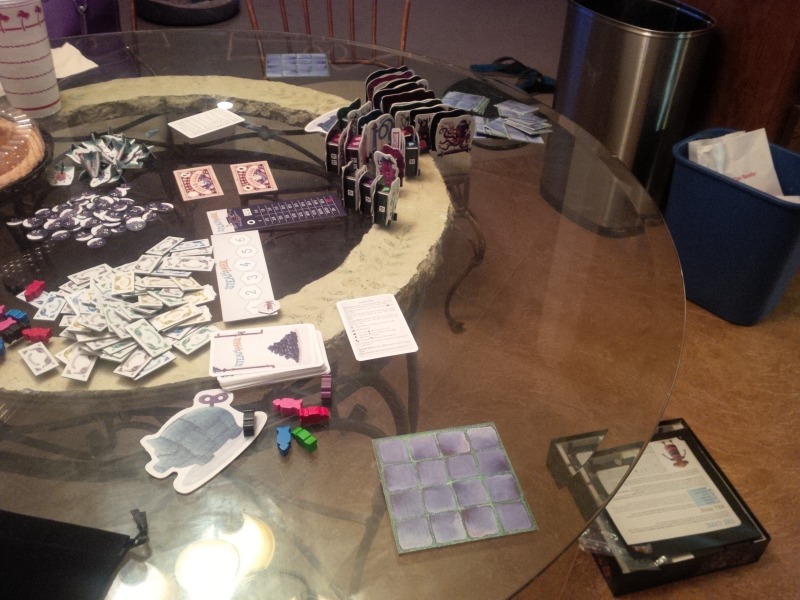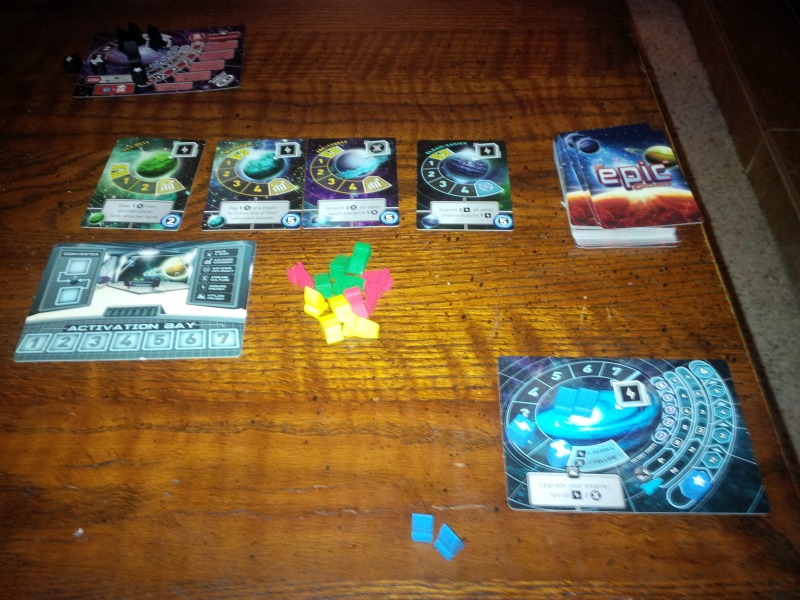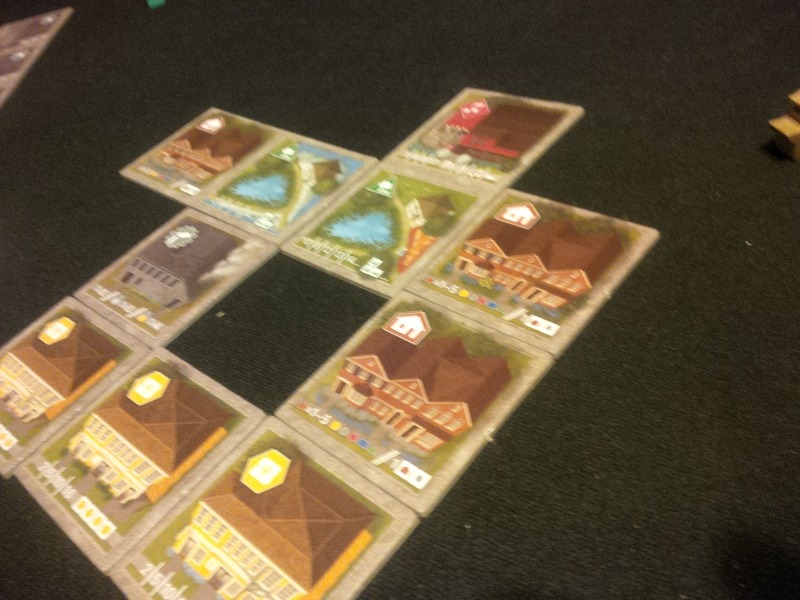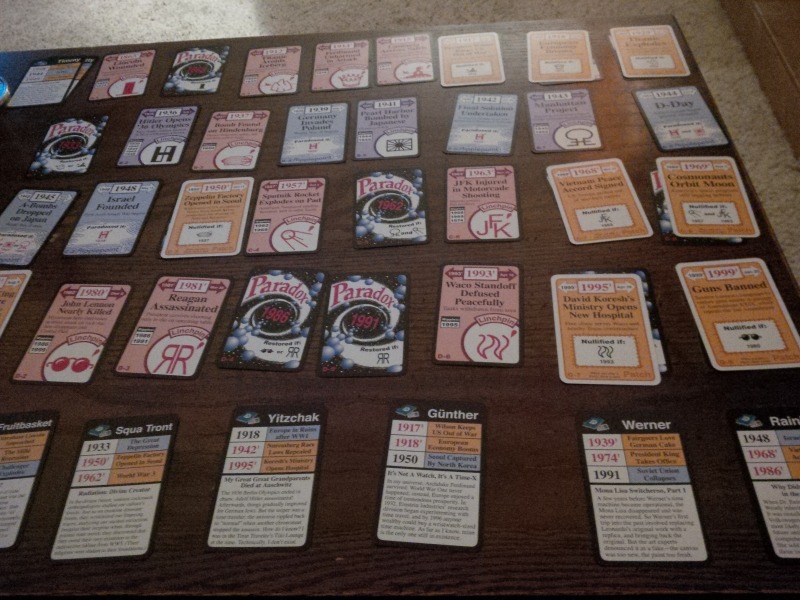Welcome to another installment of The Play’s The Thing, a regular piece with thoughts on the board and card games I’ve been playing. Here’s what I’ve played over the past week.
Published: 2013
Designers: Aureliano Buonfino, Lorenzo Silva, Lorenzo Tucci Sorrentino
Publisher: IELLO, Heidelberger Spieleverlag, others
2-4 players
90 minutes

My wife and I played this one this weekend, and we both had mixed feelings on it. There’s a cool theme of building a steam-powered amusement park for robots, and it incorporates real-time elements, die-rolling, resource management, bag-building and spatial placement into a design that’s still relatively light and fast. You’re trying to build a park that will leave you with the most money after six rounds, and you’re doing so with dice. Each face of the custom dice lets you do different things, and all players roll all their dice, locking in ones they want to keep after each round. You can reroll as many times as you want, but there are rewards for stopping and grabbing turn order tiles; once there’s only one tile left, that player takes a dirt penalty (dirt is bad, and can cost you the game entirely if you get too much or cost you money otherwise) and has just three remaining rolls to try and get what they want. Dice let you build rides or stands, play bonus cards for money, seed the bag and then try to pull visitors from it that match the colours of your rides, or clean up dirt. Rides let you attract visitors (who give you money each round), while stands give you special powers to manipulate your dice, your visitor draws, your dirt cleanup and more.

All of this works quite well, but one big challenge is the spatial placement; the game rules only allow you to place rides or stands of the same colour adjacent to each other (and even then, they can only touch at one spot), while everything else can’t touch orthogonally or diagonally. You also can’t buy two rides of the same size in one round. Given how small the starting grounds are, this leads to a significant slowdown when trying to figure out how to optimally place rides, and also plenty of dice being spent on extra grounds to expand your park (but these don’t even expand it by that much, creating placement tension again). The idea of rewarding you for specializing in one colour (something that also works with the bag-seeding idea) isn’t bad, but this seems to be an awfully-finicky process for what’s generally a light game, and it feels very restrictive. (That could be easily modified with house rules if it bugs you, though, and the tension of placement may appeal to some.) A more minor knock is that the theme’s present, but could maybe be worked in more; each ride looks different (there are roller coasters, slides, etc), but they all behave the same way, so this isn’t necessarily a full theme park simulator. It doesn’t provide the same feeling for me as something like the great computer game Roller Coaster Tycoon. With that said, though, this is still an interesting game, and one that can be quite fun. You should just be aware of what it is and isn’t before buying and/or playing it.

Published: 2015
Designer: Scott Almes
Publisher: Gamelyn Games
1-5 players
30 minutes

Scott Almes is one of my favourite designers out there, producing the tremendous Kings of Air and Steam (one of my most-loved games), the brain-burning Harbour, the Tiny Epic series and a whole bunch of upcoming ones, including Best Treehouse Ever, Loop Inc., The Great Dinosaur Rush and more. I think he’s found another hit with this one; I’ve played it both solo and with a five-player group, and it shines in both settings. This is one of the fastest-playing 4X space empire building games you can find (Eminent Domain: Microcosm‘s even quicker, but that’s about it), and it has some neat mechanics; you advance in two resources (energy and culture, which let you reroll or follow others’ actions respectively), you can land on planets and immediately use their actions or go for the longer process of adding them to your empire through diplomacy or economics, and you can upgrade your empire to roll more dice and bring in more ships. The multiplayer game is great, and the solo game stands up to it, finding a way to provide a terrific experience (with variable difficulty levels) that keeps most of the feeling of the multiplayer game without too much fiddling. I played this one solo this weekend, and had a blast with it, as usual.

Published: 2015
Designers: Philippe des Pallières, Loïc Lamy
Publishers: Lui-même, Asmodee
6-12 players
10-20 minutes
My friends opted to open up game night with a seven-player game of this Tuesday, and it’s pretty interesting. It’s a social deduction game along the lines of One Night Ultimate Werewolf or The Resistance, but the difference is that each player gets to pick their role. A cigar box full of diamonds and role tokens is passed around, and everyone can either steal diamonds or grab a role. Each role has different win conditions, as you’d expect. The godfather then starts interrogating people to try and figure out who’s stolen his diamonds; loyal henchmen want to help, thieves don’t want to be accused, FBI agents want to be accused, and the driver wants whoever’s on his right to win. This was quite interesting for the first few rounds, but overstayed its welcome a bit for me; we opted to play a full seven rounds so everyone could be godfather (as where you are in the selection order does alter things quite a bit), and that felt like too much for me.
Published: 2015
Designers: Matthew O’Malley, Ben Rosset, Morten Monrad Pedersen
Publisher: Stonemaier Games
1-7 players
20 minutes
We then went into a seven-player game of this, and I loved it. It’s 7 Wonders-style card drafting, but you’re building cities like in Suburbia, and the twist is that you have to build two cities simultaneously, one with each neighbour. Your score at the end will be the score of your lowest city (à la Tigris and Euphrates, plus lots of other games), so you have strong incentives to try and advance both and to work with both your partners (and what they’re doing with their other partners). It plays very quickly, even with seven, and there’s lots of strategy involved both in what cards you place and where you place them. I wound up winning this one in the end. It’s not surprising that I had so much fun with this, considering that it’s from designers I quite like (Rosset did the great Brewcrafters, while O’Malley has done The Princess Bride: A Battle of Wits, Diner, Knot Dice and more, and Pedersen is a Stonemaier developer who particularly specializes in creating solo variants) and a publisher with a great track record (I’ve enjoyed lots of Stonemaier Games’ different offerings, including Viticulture, and Jamey Stegmaier’s blog is terrific), but this was still a terrific experience.

Published: 2000
Designer: Andrew Looney
Publisher: Looney Labs
1-6 players
30 minutes
We split off into two groups to finish off the night Tuesday, and I played this one (I’ve been wanting this for a while, but just got it as a present from my wife) with two others. It’s such a fun time-travel game, with clever ways to alter and rewrite history and a great ripple mechanic. The multiplayer game has multiple ways to win, including acquiring the three artifacts needed for your mission, changing three moments of the timeline so you can get home, or accumulating enough power (10 cards) to dominate in the timeline you’re in, and it also has some excellent interaction between players as you each try to alter the timeline to what you need (and even that can change over time; our game saw President Kennedy flip-flop from dead to alive about five times, with the same player changing his status multiple times to take advantage of certain cards). It’s not a complicated game, and there is luck involved, but there’s plenty of strategy as well, and history buffs like myself will likely love it; there are very funny moments in this too, both from the cards and from player interactions. The solo game is also terrific, but very different, providing the challenge of manipulating the timeline to get all eight of your travellers home.

Thanks for reading! Have any thoughts on these games, or anything else you’d like to see on Board and Game? Leave them in the comments, or discuss them with us on Twitter or Facebook.
